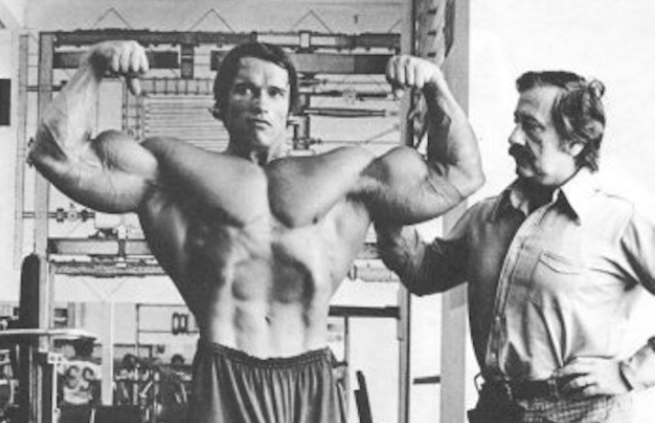WELLNESS--What makes California the very picture of healthy living? It’s neither sunshine nor silicone implants.
Our health secret is actually immigration.
While the President and others falsely blame immigrants for being sources of disease (including smallpox, which was eradicated in 1980), Californians have long known that immigrants make us healthier. (Photo above: Joe Weider, one of the famous brothers who immigrated from Canada and got Americans interested in bodybuilding, stands next to the future governor of California.)
And those health benefits go far beyond the so-called “immigrant health advantage,” the term for the research finding that new arrivals to this country are healthier than those of us born here. Throughout our state’s history, immigrants have adapted cultural practices and introduced new ideas that have expanded California’s very definition of what it means to be healthy.
Today, it is simply impossible to separate the issues of health and immigration in California. For one thing, our rapidly aging state relies heavily on immigrants to deliver our health care. In many communities, more than half of doctors are foreign-born, and statewide, one-third of the health care workers are immigrants. (Only New York and the District of Columbia are more dependent on immigrant caregivers.) And Californians’ prospects for better health care are based on medical industries that, from San Francisco to San Diego, are led by immigrants and driven by the drugs and health-monitoring devices they invent.
Immigration, and the diversity it has produced in California, also drive the now-popular idea that health is determined by our social and family relationships, and the communities in which we live. It has become conventional wisdom in California that celebrating your heritage and being grounded in community are crucial to the balance we see as a basis of mental health.
You can see the impact of immigration across all stages of life. In matters of birth, cultural practices from East Asia—such as the Chinese tradition of finding “a soup nanny” to assist a new mother in recovery in the first month after birth (drinking soup is involved)—have been imported here, and are prompting greater attention to more thoughtful post-partum care.
In our homes, multigenerational living, long associated with immigrants, has gone mainstream, with studies showing that sharing a house with your family not only saves money on rent but helps older people live longer, while reducing stress for kids.
And when it comes to the end of life, it is the attitudes of immigrants, particularly from Latin America, that have transformed how we think about death. Once a quiet and private matter, death is now more openly discussed, planned for, and celebrated everywhere from Hollywood Forever Cemetery to our massive Día de Los Muertos holidays, as Californians seek to keep our departed loved ones as a presence in our lives.
In the process, we’ve given new meaning to the quip from comedian Mort Sahl, one of many Canadian immigrants to have taught Californians that laughter is the best medicine: “You haven’t lived until you’ve died in California.”
Throughout our state’s history, immigrants have adapted cultural practices and introduced new ideas that have expanded California’s very definition of what it means to be healthy.
For better and for worse, Californians associate health with our bodies, and immigrants have shaped how we maintain them. Our devotion to wine as elixir dates back to Jean-Louis Vignes, a Frenchman who was California’s first commercial winemaker and used his resulting fortune to build a hospital.
And California’s concepts of healthy eating also have immigrant roots. Catherine Nimmo, a doctor who immigrated from the Netherlands, founded America’s first vegan society in our state in 1948. She often wrote of “the Oneness of all Life,” a California-friendly philosophy that still shapes our state’s animal protection laws.
Immigrants to California have often changed American minds when it came to diet. Spicy food was once seen as dangerous to eat. But immigrants, via such delicacies as spicy tacos and spicy curries and the Thailand-inspired wonder sauce Sriracha, convinced us otherwise. And that was quickly followed by research demonstrating that capsaicin, the compound that makes food hot, keeps us from overeating, lowers our blood pressure, and has cancer-fighting properties. Pass the jalapeños.
Eating raw fish seemed dangerous until sushi master Shigeo Saito arrived in Los Angeles from Japan in the 1960s, and he and the chefs who followed, among them Nobu Matsuhisa, began to convince us otherwise. (We don’t call it the California roll for nothing.) More recently, immigrant entrepreneurs turned Middle Eastern street foods, like hummus and falafel, into California health food staples. And, in response to an American epidemic of peanut allergies, Israeli emigrants have contributed to the popularity of a baby-friendly peanut puff called Bamba, which Trader Joe’s now sells.
Then, when we burn off those calories so we can look more like the beautiful immigrants Hollywood casts in films, we lean heavily on practices brought here by immigrants.
What is more California than a yoga workout? The state has seen waves of immigrant yogis make and remake yoga practice, from the guru Paramahansa Yogananda (who founded the Self-Realization Fellowship in L.A. in 1920) to Russian-born Indra Devi (who started yoga schools in Hollywood in the 1950s) to, in our era, Bikram Choudhury (known for hot yoga before he became a fugitive).
And after an hour on the yoga mats, Californians love nothing more than a soak in a hot tub, an idea that came from Japan and was adapted by California winemakers, who used their barrels to make the first such baths. Or if you’re really hurting, you might slip into a whirlpool bath, with jets first invented as a rheumatoid arthritis cure by an Italian immigrant to California named Candido Jacuzzi.
It is no exaggeration to say that Californians have chosen to be ruled by immigrant visions of health. After all, it was two brothers from Canada, Joe and Ben Weider, who popularized bodybuilding and working out with weights, sparking the gym industry that is an inescapable feature of the state landscape.
The Weiders were helped in this work by a young man who, at their urging, immigrated to Los Angeles from Austria. Arnold Schwarzenegger became such an avatar of muscular American fitness that Californians elected him governor in 2003.
He couldn’t balance the budget, but he got good reviews for his policies on health care.
(Joe Mathews writes the Connecting California column for Zócalo Public Square … where this piece was first posted.)
-cw

















